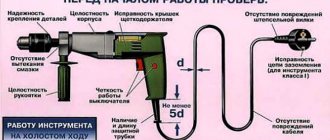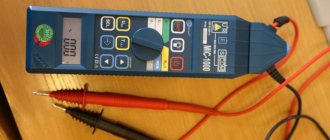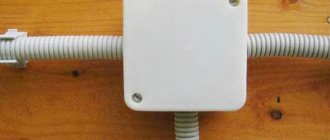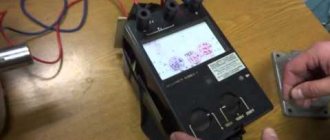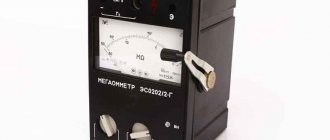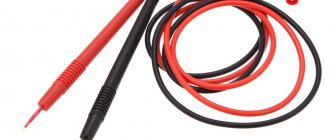General safety requirements
1.1. Persons at least 18 years of age who have undergone a medical examination, been trained in safe working methods and have passed exams in accordance with the current Regulations on the procedure for training and testing knowledge on labor protection of managers, specialists and workers of enterprises, institutions and communications organizations are allowed to carry out measurements with a megohmmeter.
1.2. In installations with voltages above 1000 V, measurements are carried out by order of two persons from electrical personnel, one of whom must have an electrical safety group of at least IV, and in installations with voltages up to 1000 V, measurements are carried out by order of two persons, one of whom must have an electrical safety group not below III.
1.3. The personnel conducting the measurements are obliged to:
1.3.1. Comply with internal labor regulations.
1.3.2. Be able to provide first aid to victims of electric current and accidents.
1.3.3. In case of injury or illness, notify your immediate supervisor.
1.3.4. The victim or eyewitness immediately notifies the immediate supervisor of each accident.
1.4. When working with a megohmmeter, you may be exposed to dangerous voltage in an electrical circuit, the closure of which can occur through the human body.
1.5. In accordance with the Standard Industry Standards for the free provision of special clothing, special footwear and other personal protective equipment to communication workers, each employee must be provided with a cotton robe (GOST 11622-73)*.
1.6. For failure to comply with this Instruction, those responsible will be held accountable in accordance with the internal labor regulations or penalties determined by the Labor Code of the Russian Federation*.
_________________
* Currently - the Labor Code of the Russian Federation.
Instructions for labor protection when working with a megohmmeter
1. General labor protection requirements
1.1. This instruction was developed on the basis of standard instructions for labor protection when working with the TOI R-45-036-95 megohmmeter.
1.2. Persons at least 18 years of age who have undergone a medical examination, been trained in safe working methods and have passed exams in accordance with the current Regulations on the procedure for training and testing knowledge on labor protection of managers, specialists and workers of enterprises, institutions and communications organizations are allowed to carry out measurements with a megohmmeter.
1.3. In installations with voltages above 1000 V, measurements are carried out by order of two persons from electrical personnel, one of whom must have an electrical safety group of at least IV, and in installations with voltages up to 1000 V, measurements are carried out by order of two persons, one of whom must have an electrical safety group not below III.
1.4. The personnel conducting the measurements are obliged to:
— comply with internal labor regulations;
- be able to provide first aid to victims of electric current and in case of industrial accidents;
— in case of injury or illness, notify your immediate supervisor;
— the victim or eyewitness immediately notifies the immediate supervisor of each accident.
1.5. When working with a megohmmeter, you may be exposed to dangerous voltage in an electrical circuit, the closure of which can occur through the human body.
1.6. The employee must be provided with special clothing, special shoes and other personal protective equipment in accordance with the Model Industry Standards for the free issuance of protective equipment in their main specialty.
1.7. For failure to comply with this Instruction, employees are held accountable in accordance with the current legislation of the Russian Federation.
2. Safety requirements before starting work
2.1. Before starting work, the employee must:
— wear special clothing, safety shoes, and personal protective equipment;
— receive instructions from the head of the department on how to carry out this work and the conditions for its implementation;
— remove devices and tools not used in performing this work;
— by external inspection, make sure that the megohmmeter is in good working order (the megohmmeter must have a tag indicating that it has passed state verification).
- make sure that there are no people working on that part of the electrical installation to which the megohmmeter is connected, prohibit persons located near it from touching live parts.
2.2. Work with a megohmmeter must be carried out in accordance with the requirements of the operating instructions for the megohmmeter and the instructions for labor protection when working with a megohmmeter.
2.3. The employee must inform the immediate supervisor of the work about all noticed malfunctions of the megohmmeter and not begin work until they are eliminated.
3. Safety requirements during operation
3.1. During operation, it is allowed to use only insulated connecting wires to the megohmmeter with special crocodile tips.
3.2. It is not allowed to leave one employee to perform work.
3.3. It is prohibited to take measurements on one circuit of double-circuit lines with a voltage above 1000 V, while the other circuit is energized, on a single-circuit line if it runs in parallel with an operating line with a voltage above 1000 V.
3.4. It is prohibited to measure with a megohmmeter during a thunderstorm or when it is approaching.
3.5. When measuring insulation resistance in power conductors, it is necessary to turn off power receivers, as well as devices, instruments, etc.
4. Safety requirements after completion of work
4.1. Turn off all measuring equipment.
4.2. Discharge the circuits under the influence of the megohmmeter.
4.3. Remove the workplace, tools, fixtures, devices, protective equipment, and protective clothing.
4.4. Make the necessary entries in operational and technical documentation.
Similar articles:
- Instructions for labor protection when working with hand-held electric tools Instructions for labor protection when working with hand-held electric tools 1. General labor protection requirements 1.1. To work with manual electric...
- Instructions on labor protection when working on a vertical drilling machine Instructions on labor protection when working on a vertical drilling machine 1. General labor protection requirements 1.1. This manual is based on…
- Instructions for labor protection when working with a gas generator and a diesel generator. Instructions for labor protection when working with a gasoline and diesel generator. Safety measures before the start of work, during work, at the end...
Safety requirements before starting work
2.1. Before starting measurements, it is necessary to make sure that there are no people working on the part of the electrical installation to which the megohmmeter is connected, and to prohibit persons located near it from touching live parts.
2.2. Wear special clothing.
2.3. It is prohibited to take measurements on one circuit of double-circuit lines with a voltage above 1000 V, while the other circuit is energized, on a single-circuit line if it runs in parallel with an operating line with a voltage above 1000 V.
2.4. It is prohibited to measure with a megohmmeter during a thunderstorm or when it is approaching.
2.5. When measuring insulation resistance in power conductors, it is necessary to turn off power receivers, as well as devices, instruments, etc.
2.6. By external inspection, make sure that the megohmmeter is in good working order (the megohmmeter must have a tag indicating that it has passed the state inspection).
OCCUPATIONAL SAFETY REQUIREMENTS IN EMERGENCIES
4.1. If during operation any malfunction of the megohmmeter is discovered, work with it must be stopped immediately, and the faulty megohmmeter must be handed over for inspection and repair. 4.2. If there is a sudden loss of voltage in the network, the megohmmeter must be disconnected from live parts. 4.3. In the event of an accident, you must immediately provide first aid to the victim, call a doctor by calling 103 or 112 or help take the victim to a doctor, and then inform the manager about the incident. 4.4. If an injury occurs due to exposure to electric current, then first aid measures depend on the state in which the victim is after he is released from the action of electric current: 4.4.1. If the victim is conscious, but has previously fainted, he should be placed in a comfortable position and ensure complete rest until the doctor arrives, continuously monitoring his breathing and pulse; Under no circumstances should the victim be allowed to move. 4.4.2. If the victim is unconscious, but with stable breathing and a pulse, he should be placed comfortably, his clothes unbuttoned, a flow of fresh air created, ammonia sniffed, sprinkled with water and complete rest ensured. 4.4.3. If the victim is breathing poorly (very rarely and convulsively), he should undergo artificial respiration and cardiac massage; if the victim has no signs of life (breathing and pulse), he cannot be considered dead, artificial respiration should be performed continuously both before and after the arrival of the doctor; The question of the futility of further artificial respiration is decided by the doctor. 4.5. If a fire or signs of combustion are detected (smoke, burning smell, increased temperature, etc.), you must immediately notify the fire department by calling 101 or 112. 4.6. Before the fire department arrives, measures must be taken to evacuate people and property and begin extinguishing the fire.
Megaohmmeter
Insulation, like any other material, is influenced by various external factors: weather, mechanical wear and others. For timely detection of insulation defects, there is a device, the so-called megohmmeter. It measures insulation resistance.
Operating principle of the device
What the device is intended for can be understood from its name, which is formed from three words: “mega” - the dimension of the number 10 6; “ohm” - a unit of resistance and “meter” - to measure. To measure electrical resistance in the megohm range, a megohmmeter is used. The principle of operation of the device is based on the application of Ohm's law, from which it follows that the resistance (R) is equal to the voltage (U) divided by the current (I) flowing through this resistance. Therefore, in order to implement this law in a device, you need:
- DC generator;
- measuring head:
- terminals for connecting the measured resistance;
- a set of resistors for operation of the measuring head within the working area;
- a switch that switches these resistors;
Implementation of a megohmmeter according to this scheme requires a minimum of elements. It is simple and reliable. Such devices have been working properly for half a century. The voltage in such devices is supplied by a direct current generator, the value of which varies in different models. Usually it is equal to 100, 250, 500, 700, 1000, 2500 volts. Different models of devices may use one or more voltages from this series. Generators differ in power and, accordingly, in size. Such generators are operated manually. To operate, you need to twist the handle of a dynamo, which produces direct current.
Currently, electromechanical devices are being replaced by digital ones. In such devices, either galvanic cells or batteries are used as direct current sources. There are also new models with a built-in power supply.
Working with a megohmmeter
Working on any equipment with this device is a high-risk job due to the fact that the device generates high voltage and there is a possibility of electrical injury. Work with this device is permitted to be carried out by personnel who have studied the instructions for working with the device, in accordance with the rules of labor protection and safety precautions when working in electrical installations. The employee must have the appropriate access group and periodically undergo tests on knowledge of the rules of work in electrical installations, know the instructions on labor protection, including the use of a megohmmeter.
Typically, this device measures the insulation resistance of cable lines, electrical wiring and electric motors. Devices must undergo periodic inspection by the metrological service and have the appropriate documents. It is prohibited to carry out measurements with an untested device; it must be taken out of service and sent for inspection.
Before starting work using a megohmmeter, you need to ensure the integrity of the device by visual inspection. There should be a verification stamp on it, there should be no chips on the device body, the indicator glass should be intact. Test leads are checked for insulation damage. The device needs to be tested. To do this, it is necessary, if a pointer instrument is used, to install it on a horizontal surface in order to avoid measurement errors and carry out measurements with open and closed probes.
On older models of megohmmeters, measurements are carried out by rotating the generator handle at a constant frequency of 120–140 rpm. On other models, measurements are made by pressing the corresponding button on the device. The megohmmeter should show infinity and zero megohms, respectively. After this, you can begin work on measuring insulation resistance.
Instrument measurements
The design of this type of work differs at different enterprises. In some organizations, this work is carried out according to a work permit, in others, by order or as part of routine operation. It is important that the general execution rules are the same. Let’s take as an example the technology for measuring the insulation resistance of communication cables in railway transport. Having completed all the necessary organizational and technical measures (designing the work, hanging posters, etc.), we proceed directly to the measurements.
Having selected the pair on which you want to measure, you first need to check that there is no voltage on it. Using the previously prepared ground electrodes, we remove the charge from the cable cores being measured and ground them. Having installed the measuring probes and removed the ground electrodes, we measure the insulation resistance with a megohmmeter. Having recorded the results obtained, switch the measuring probe to another core and repeat the measurement procedure.
It must be remembered that after measurements are taken, an electrical charge remains in the cable. After completing the measurements, it is necessary to remove the electrical charge using a grounding electrode. It is necessary to discharge the megohmmeter itself. This is done by short-circuiting the measuring cords to each other. Work on installing measuring probes and grounding conductors is carried out wearing dielectric gloves.
Step-by-step instructions for measuring insulation resistance with a megohmmeter
Despite the fact that using a megohmmeter is not difficult, when testing electrical installations it is necessary to adhere to the rules and a certain algorithm of actions. To search for insulation defects, a high level of voltage is generated, which can pose a danger to human life. Safety requirements during testing will be considered separately, but for now we will talk about the preparatory stage.
Preparation for testing
Before testing the electrical circuit, it is necessary to de-energize it and remove the connected load. For example, when checking the insulation of home wiring in an apartment panel, it is necessary to turn off all AVs, RCDs and differential circuit breakers. The plug connections should be opened, that is, electrical appliances should be disconnected from the sockets. If lighting lines are tested, light sources (lamps) should be removed from all lighting fixtures.
The next step in the preparatory stage is the installation of portable grounding. With its help, residual charges are removed from the circuit under test. It is not difficult to organize portable grounding; for this we need a stranded conductor (necessarily copper), the cross-section of which is at least 2.0 mm 2. Both ends of the wire are freed from insulation, then one of them is connected to the grounding bus of the electrical panel, and the second is attached to the insulating rod; in the absence of the latter, you can use a dry wooden stick.
The copper wire must be attached to the stick in such a way that it can touch the current-carrying lines of the circuit being measured.
Connecting the device to the line under test
Analog and digital megohmmeters are equipped with 3 probes, two ordinary ones, connected to the “Z” and “L” sockets, and one with two tips for the “E” contact. It is used when testing shielded cable lines, which are practically not used in everyday life.
To test single-phase household wiring, we connect single probes to the appropriate sockets (“ground” and “line”). Depending on the test mode, we attach alligator clips to the wires being tested:
- Each wire in the cable is tested against the other wires that are connected together. The wire under test is connected to the “L” socket, the remaining wires connected together to the “Z” socket. A similar connection diagram is shown in the figure.
Connecting a megohmmeter
If the indicators meet the standard, then testing can be completed, otherwise testing continues.
- Each of the wires is tested relative to ground.
- Each wire is checked in relation to other wires.
Test algorithm
Having considered all the main stages, you can proceed directly to the order of actions:
- Preparatory stage (fully described above).
- Installation of portable grounding to remove electrical charge.
- The voltage level is set on the megohmmeter; for household wiring - 1000.0 volts.
- Depending on the expected result, the resistance measurement range is selected.
- Checking the de-energization of the tested object, this can be done using a voltage indicator or a multimeter.
- Special crocodile probes of the measuring wires are connected to the line.
- Disconnecting portable grounding from the tested object.
- High voltage is supplied. In electronic megohmmeters, to do this, just press the “Test” button; if you are using an analog device, you should rotate the dynamo handle at a given speed.
- We read the device readings. If necessary, the data is entered into the measurement protocol.
- We remove residual voltage using portable grounding.
- We disconnect the measuring probes.
To measure the condition of other current-carrying conductors, the procedure described above is repeated until all elements of the object are checked, that is, we are talking about the end of measurements when testing electrical equipment.
Based on the test results, a decision is made on the possibility of operating the electrical installation.
